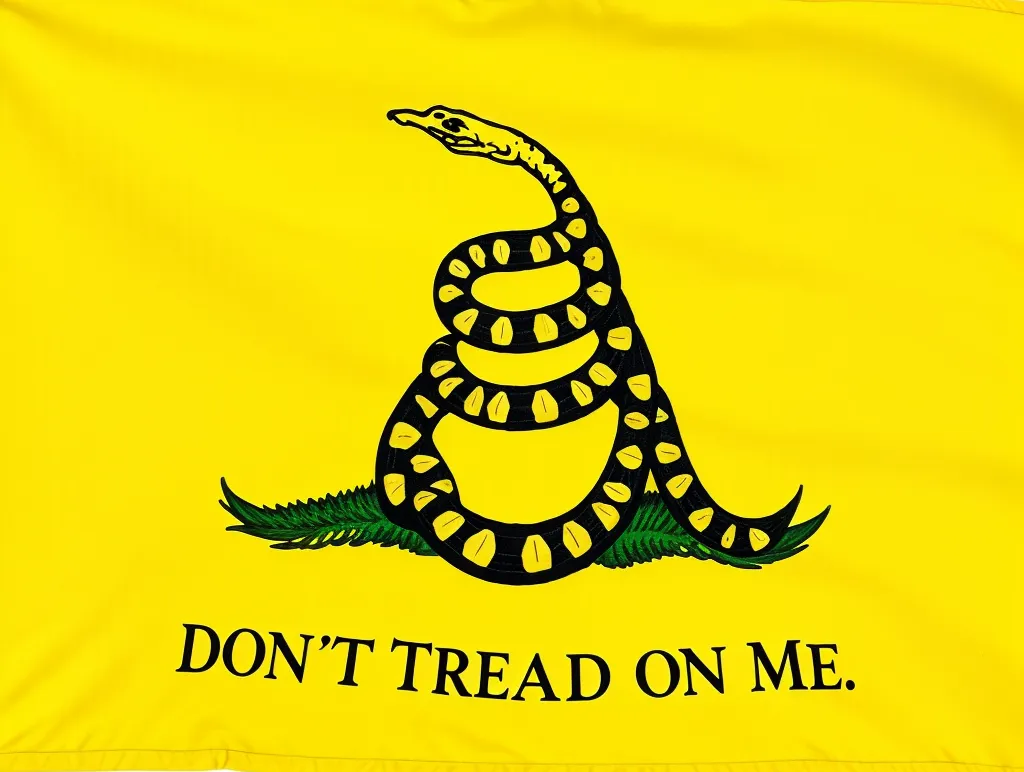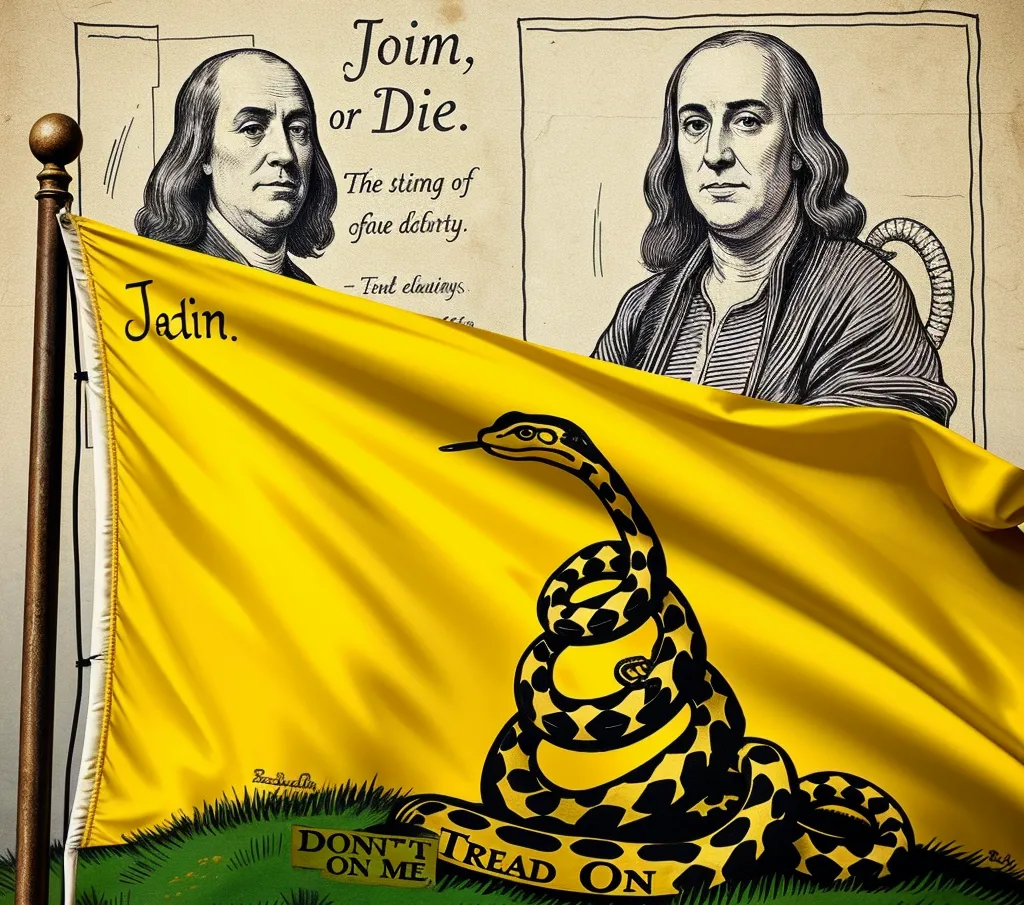The Gadsden flag is a historical American flag with a yellow background featuring a coiled rattlesnake and the bold words “Don’t Tread on Me.”
It was designed during the American Revolution by Christopher Gadsden, a South Carolinian who served as a delegate to the Continental Congress and as a brigadier general in the Continental Army.
The flag was first unfurled on the main mast of the USS Alfred on December 20, 1775, when Commodore Esek Hopkins became the naval commander in chief of the Continental Navy.
This iconic design, with its coiled rattlesnake, was meant to serve as a personal ensign and a symbol of the resolve and unity of the Thirteen Colonies.
The Gadsden Flag

Benjamin Franklin’s political cartoon “Join, or Die” was published in 1754. It featured a rattlesnake to represent unity among the American colonies.
The Gadsden flag represents the values of watchfulness, protection, and freedom from the Revolutionary War. The flag represents different parts of American culture, such as freedom and political movements like the Tea Party.
The Gadsden flag remains a powerful emblem, representing different ideologies and the enduring spirit of defiance against oppression.
Join or Die in War
“Join or Die” is from a cartoon made by Benjamin Franklin in 1754. It shows a snake cut into pieces, with each piece representing a different American colony. The cartoon was made to encourage the colonies to unite during the Albany Congress.
This image powerfully symbolized the necessity for unity among the colonies, especially in the face of threats like the French and Indian War and later during the Revolutionary War. The rattlesnake symbol used in the cartoon was later adopted in various flags, including the Gadsden flag.
The motto “Don’t tread on me!” It featured the sentiment of Benjamin Franklin’s appeal for unity on these flags, including those flown by the Marine Corps and the Continental Navy. Congress, such as on the USS Alfred under the command of Commodore Esek Hopkins. This message of unity and defiance became a rallying cry for the colonies in their struggle for independence. They were integral to creating the United States as a unified nation.
Gadsden Flag: History and Controversy

The Gadsden flag is a famous American flag with a yellow background. It has a coiled rattlesnake and the motto “Don’t Tread on Me.”
This flag was created during the American Revolution by Christopher Gadsden. Gadsden was a delegate from South Carolina to the Continental Congress and a general in the Continental Army.
In 1775, Commodore Esek Hopkins received a flag for the USS Alfred, the main ship of the Continental Navy.
The flag quickly became a powerful symbol of the fight for independence, representing the determination and unity of the Thirteen Colonies.
Over time, various groups have embraced the Gadsden flag, each interpreting its message differently. In recent years, it has appeared in popular culture and has been linked to libertarian undertones and the Tea Party movement.
However, its use has also sparked controversy, especially during events like the January 6 U.S. Capitol attack in Washington, D.C., where it was seen among supporters of Donald Trump.
Also Read: Your Awaits: The Ultimate Utopia Guide long Island
The Gadsden flag represents different ideas and means different things to different people. Some see it as a symbol of American values and freedom, while others associate it with racism and extreme politics.
Despite these differing views, the flag is an important part of American history. It evokes strong emotions and sparks discussions.
In January of 2014
In January 2014, a Black maintenance worker at the US Postal Service in Denver complained about racial discrimination.
The problem started when a colleague kept wearing a hat with a snake and the words “DON’T TREAD ON ME” on a yellow background. The Postal Service initially dismissed the complaint, but the Equal Employment Opportunity Commission (E.E.O.C.) later reversed this decision and ordered an investigation.
The case drew attention from various media outlets and sparked debates, with some arguing whether the Gadsden Flag could be interpreted as a racist symbol.
Eugene Volokh, a professor at the U.C.L.A. School of Law, discussed this incident on his legal affairs blog “Volokh Conspiracy” on the Washington Post website. Using historical symbols in modern times can be complicated. This is especially true when they are mixed with different beliefs and accusations of racial harm.
Gadsden Flag at the January 6 U.S. Capitol Attack

The Gadsden flag, with its iconic “Don’t Tread on Me” motto, was prominently displayed during the January 6, 2021, attack on the U.S. Capitol in Washington, D.C. This event, which involved supporters of Donald Trump, brought the flag back into the spotlight, but in a context that sparked widespread controversy.
The Gadsden flag represents American independence. Now, it is associated with the Tea Party movement and right-wing populism. During the Capitol attack, the flag highlighted the strong differences in beliefs in the United States. Some saw it as a symbol of American values and standing up against government control.
In contrast, others saw it as a symbol tainted by racism and racial undertones. The 21st century has seen the flag’s meaning evolve, influenced by events and cultural shifts, such as its use by Nike and Major League Soccer in 2006 and the broader political landscape shaped by figures like Barack Obama, the first Black president of the United States.
As for Gadsden’s Creation
As for Gadsden’s creation, the Gadsden flag was designed by Christopher Gadsden during the American Revolution in 1775. As a brigadier general in the Continental Army and a representative from South Carolina to the Continental Congress, Gadsden aimed to design a symbol that symbolized the spirit of independence And resistance against British rule.
He presented the flag, with its coiled rattlesnake and the motto “Don’t Tread on Me,” to Commodore Esek Hopkins, who used it as his ensign aboard the USS Alfred, the Continental Navy’s flagship. This flag became one of the earliest symbols of American defiance, representing the ideals of liberty, individualism, and vigilance.
Although the Stars and Stripes later became the official flag of the United States, the Gadsden flag continued to be a potent Revolutionary relic. Libertarian circles in the nineteen-seventies later embraced it. The flag’s design has since become a widely recognized icon of minimal government and individual rights, with a resurgence in popularity during political tension, such as after the September 11 terrorist attacks and the rise of the Tea Party movement.
Closing Thoughts
The Gadsden flag has journeyed from its origins in the American Revolution to become a symbol with varied interpretations in modern times. Initially created by Christopher Gadsden as a rallying emblem of liberty and resistance, it was meant to inspire the Thirteen Colonies during their fight for independence.
Over the centuries, the flag has evolved and been adopted by different movements, each imbuing it with new positive and controversial meanings. From its use by Commodore Esek Hopkins in the Continental Navy to its presence at contemporary political events, the Gadsden flag remains a potent symbol in American history.
Whether viewed as a proud representation of individualism and defiance or a contentious emblem tied to modern ideologies, its impact on the American ethos is undeniable. The flag’s enduring legacy reminds us that symbols, much like the coiled rattlesnake it depicts, carry power that can provoke, inspire, and challenge across generations.
FAQs:
What does the Gadsden flag symbolize?
The Gadsden flag symbolizes liberty, vigilance, and resistance to oppression from the American Revolution.
Who designed the Gadsden flag?
Christopher Gadsden, a South Carolinian delegate to the Continental Congress, designed the flag in 1775.
What is the significance of the coiled rattlesnake?
The coiled rattlesnake represents vigilance and readiness to defend against threats, a key symbol of American independence.
Where was the Gadsden flag first used?
The flag was first used as Commodore Esek Hopkins’ personal ensign aboard the USS Alfred during the American Revolution




